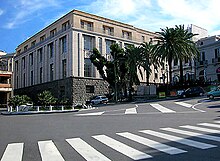Museo Nazionale della Magna Grecia

The Palazzo Piacentini which houses the museum as seen from the Piazza Indipendenza
|
|
| Established | 1882 |
|---|---|
| Location | Palazzo Piacentini, Piazza De Nava, 26-89100 Reggio Calabria, Italy |
| Coordinates | 38°06′53″N 15°39′04″E / 38.114722°N 15.651111°ECoordinates: 38°06′53″N 15°39′04″E / 38.114722°N 15.651111°E |
| Website | www |
The Museo Nazionale della Magna Grecia (National Museum of Magna Græcia), Museo Archeologico Nazionale di Reggio Calabria (National Archaeological Museum of Reggio Calabria) or Palazzo Piacentini is a museum in Reggio Calabria, southern Italy, housing an archaeological collection from sites in Magna Graecia.
Initially formed with a nucleus of material ceded from the city's Museo Civico in the 19th century, the Museo Archeologico Nazionale della Magna Grecia then grew via many discoveries in various excavation campaigns in the ancient city-states of Calabria, Basilicata and Sicily by the Soprintendenza Archeologica della Calabria right up to the present day, including the Riace bronzes. They are extremely important for studies of the 8th century BC, but also has several objects from the prehistoric and protohistoric periods which preceded it and the ancient Roman and Byzantine eras which followed. Today new finds in Calabria are no longer displayed and conserved in a single museum, but exhibited where they have been found, since the quantity of new discoveries has allowed smaller local museums to be set up for them (at Crotone, Locri, Roccelletta di Borgia, Sibari, Vibo Valentia and Lamezia Terme). These are taken together as the museo reggino.
The most notable of its collections include:
The building was designed by Marcello Piacentini (from whom it takes its name) and built between 1932 and 1941. Characterised by its massive volume and monumentality, it consists of a ground floor in 'bugnato' black lava stone, linking the different heights of the Corso Garibaldi and the Via Vittorio Veneto. On this rest grand travertine pilasters and large windows for the first floor exhibition galleries. These large windows make the galleries open, airy and light and allow smoother and more continuous routes between them. On the main facade is a series of large illustrations of the ancient currencies of the cities of Magna Graecia. After the opening many rooms on the ground floor were also opened to the public as galleries (though not designed as such) and today the Museum occupies all the available space on all the floors (three floors and a basement).
...
Wikipedia

